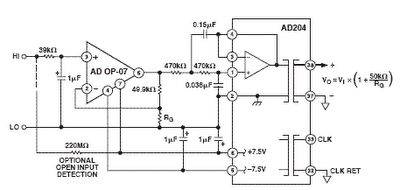Isolate 4-20mA to Voltage Circuit
The AD202 and AD204 are general purpose, two-port,
transformer-coupled isolation amplifiers that may be used in
a broad range of applications where input signals must be
measured, processed, and/or transmitted without a galvanic
connection.
AD202/AD204 application circuit
Picture shows an isolator receiver that translates a 4-20 mA
process current signal into a 0 V to 10 V output. A 1 V to 5 V
signal appears at the isolator’s output, and a –1 V reference
applied to output LO provides the necessary level shift
(in multichannel applications, the reference can be shared by
all channels). This technique is often useful for getting offset
with a follower-type output buffer.

The circuit as shown requires a source compliance of at least
5 V, but if necessary that can be reduced by using a lower value
of current-sampling resistor and configuring the input amplifier
for a small gain.














